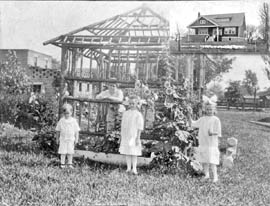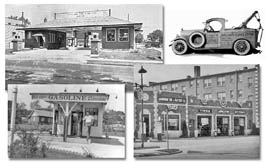| |
Nesbitt Girls |
|
Fred, Frances, and Betty Nesbitt (left to right) are shown standing in
front of their grandfather Howell’s rose pergola at 1082 Broadview Avenue
around 1914. Their mother Louise Howell Nesbitt is inside the pergola.
The Nesbitt family home at 1049 Grandview Avenue, shown in the 1911 photograph
(inset), was originally part of the extensive Howell family estate and
was a wedding gift from Louise's father. It is located across the street
from the entrance to the Grandview Heights Municipal Building. Betty, the
last surviving grandchild, died last month at 99 years of age. She graduated
from GHHS in 1925 and attended The Ohio State University. She married William
F. Aschinger, Jr. whose family owned and operated the Columbus Showcase
Co. The original factory was built on property acquired from the Sells
Circus on Fifth Avenue near Olentangy River Road and was recently razed
and replaced by the Meridian apartment complex. |
|
| |
Early View of Fifth Avenue |
|
The location of this dog playing on a sand pile was erroneously
identified in our archival database as being the current site of Trinity
Methodist Church at the southwest corner of Cambridge Blvd. and Fifth
Avenue. After research analysis of the photograph, it has
been determined to be a panoramic view looking southeast towards Arlington
Avenue from the future site of Roxbury Road north of Fifth Avenue in
Upper Arlington. The greenhouse, houses, and barns (left in the image)
line Fifth Avenue. The
large three-story Victorian foursquare house to the right of the greenhouse
is the home at 1564 Arlington Avenue, which was built in 1903. There
is evidence to suggest that the greenhouse was part of the Fifth
Avenue Florist Company, one of the most successful and longstanding floral
businesses in Columbus. Founded by Claude Seibert, Grandview Heights
entrepreneur and mayor from 1915-1919, the florist’s greenhouses were
recorded to be on Fifth Avenue and the original retail shop was on East
Broad Street. |
|
|
Early Grandview Service Stations |
|
In the early days of the automobile, gasoline was poured by hand from
a storage container into the tank of the car. This changed when John Tokheim
patented the Tokheim Visible Measuring Pump early in the 20th century.
It was originally used to dispense cider and vinegar, but was modified
to be used as a gasoline pump, and this resulted in the proliferation of
the gasoline service station. Grandview had its share of these new gas
stations, including the four featured in this photo composition. The lower
left image shows Norman Reed, son of the Grandview Village Marshal, at
the Red Crown station on West First near Fairview leaning on an early Tokheim
Visible Pump. Later on First at Fairview was Harry Walcutt's Tri-Village
Tire and Battery (upper left) also showing the Tokheim Pumps in the drive
through bay. The Grandview Tire and Battery station (lower right) was recently
razed to build the condominiums at Third and Grandview. Arch Yost's Boulevard
Service Station was located near the post office on Grandview Avenue on
the site of the shopping center that houses Caribou Coffee. His tow truck
is shown at the upper right. |
|
| |
Aerial View of Broadview and Grandview
Terrace |
|
The aerial photo above was taken in 1960 from the air above Wyman Woods,
looking toward the west. Grandview's Municipal Building, before the office
addition was added in 1963, can be seen at the lower right . The area between
Grandview Avenue (bottom), Goodale Blvd. (left) and the Broadview hill
(top) shows the subdivision development that started in the earliest days
of Grandview history (1832) and culminated with the 1957 Broadview Terrace
(upper right). Grandview's earliest building, the Franklin County Poorhouse,
is the home in the center of the photo. Note the green space at the corner
of Goodale and Broadview at the center left, before homes were built there
in 1963 and 1965 and most recently in 1994. |
|
| |
Mary Jane Price Griswold |
 |
Mary Jane Price (lower left), the second child of Timothy J. and Mary
Roberts Price, was born in Utica, New York in 1839 and moved to Columbus
with her family in 1864. She married Charles Courtland Griswold, owner
of Griswold and Sohl, world famous manufacturers of carriage accessories.
Their estate, Dolgradog (Welsh for Lord of the Valley), shown from three
views, was on Roxbury where the French Quarter is currently located. Noted
philanthropists and society mavens, they amassed a large fortune and entertained
lavishly. One circa 1900 garden party included 300 guests who were transported
by 2 special trains from Columbus to Marble Cliff. A special dance pavilion
was built for the occasion and the grounds lit with tiny lights. The local
press reported that guests were received by Mary Jane, dressed in black
silk and diamond ornaments, and dined al fresco. Mary Jane gave $400,000
in memory of her husband to build the Griswold Memorial Building of the
YWCA in 1926. She also left large sums to the Salvation Army, Girl Scouts,
Camp Fire Girls, and the YMCA. Her major impact on local history was her
bequest of large tracts of land along Dublin Road to the Village of Marble
Cliff. The land was sold to commercial interests and provided a sound tax
base for the village. |
|
| |
Midnight at the Arlington Riding
Club |
 |
This photograph is from a 1929 copy of "Soundings" a publication
of the Columbus Junior League. It shows the race track at the Arlington
Country Club from around 1900. The country club was a large complex consisting
of a club house, dance hall, stables, and a race track. It was the first
country club in central Ohio and was located south of Third Avenue and
west of present day Arlington Avenue, which did not extend south of Third
until 1923. The building in the background with the large chimney is the
dance hall. The original caption reads, "Helen Brown chaperoned by
Paul Loving shows "Midnight" at the Arlington Country Club".
Naming a white horse "Midnight" is still a humorous curiosity.
Horse racing and other horse related activities were the main events at
the country club at the time, and golf did not become a prominent feature
until approximately 1905. |
|
| |
Urlin Hunting Party |
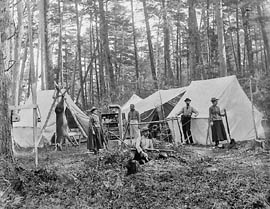 |
The rustic hunting campsite photograph was provided by the granddaughter
of George Urlin, Grandview Heights entrepeneur and pioneering developer.
Urlin and his business associates were responsible for laying out the plan
for much of what would become the original Grandview village. George is
reclining in the foreground with his dog and shotgun and his wife Alice
is standing on the left with her gun. The other individuals are not identified,
but the man wearing an apron standing near the camp stove is assumed to
be a domestic. The large hanging buck waiting to be dressed suggests that
Mr. Urlin was a serious hunter as well as businessman. The location and
date of the photograph are not known but presumed to date prior to 1900. |
|
| |
Julius Stone & Sons |
 |
Julius Stone, Sr. (seated right) and his sons Julius Jr, George, and
Franz playing chess around 1914. Julius Stone was an internationally renowned
explorer, scientist, entrepreneur, and philanthropist. Famous in their
own right, Julius Jr. is credited with saving Key West from financial
ruin in 1935 and George piloted the first plane to land at Don Scott Field
in 1942. A colonel in the Civil Air Patrol, George died in a plane crash
at the age of 46. The Stone estate occupied most of the acreage on the
west side of Westwood south of Bluff. Julius lived there for 38 years with
his sons, wife Edna, and daughters Theodora and Natalia before moving to
Santa Monica, California in 1942. The family property was developed in
1993 and was fittingly named Stonegate Village. |
|
| |
Our Lady of Victory Academy |
 |
Our Lady of Victory Academy opened on September 25, 1922 shortly after
the Columbus Catholic Diocese purchased the four-acre Merkle estate at
the corner of Cardington and Roxbury and established Our Lady of Victory
Parish. Prior to building a church in 1923 and a school in 1931, the Merkle
mansion served as a church, convent, and school. Fifty-one students were
initially enrolled. Three nuns from the Sisters of Charity of Nazareth
conducted classes, and tuition was one dollar per month. This photograph,
donated by Dorothy Lang, shows the first eighth grade graduation class
of four boys and four girls with their pastor, Monsignor Thomas Nolan (center).
They are standing with their diplomas in front of the main entrance to
the original chapel on Roxbury Road in the spring of 1929. |
|
| |
Reed & Herrick |
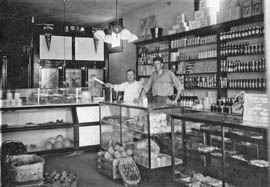 |
William Reed (left) and Hobart Herrick (right) are shown inside Herrick
and Reed Groceries at the northeast corner of Wyandotte and Fifth Avenues
in 1914. Herrick sold his interest to Reed in 1916 and the store was renamed
the Wyandotte Market (it was until recently the Stewart Wine store). Typical
of the period, shopping was not the hands-on experience we know today.
Cans were stacked on high shelves behind the counter, and fresh and seasonal
local produce were stacked in baskets around the interior of the store.
Clients presented the grocer lists and groceries were retrieved for them
by the clerks. There were no shopping carts, and home deliveries with the
store truck were the norm. The store also had a small Auto Filling Station
pump outside the front door on the sidewalk. |
|
| |
Ezio Cherubini |
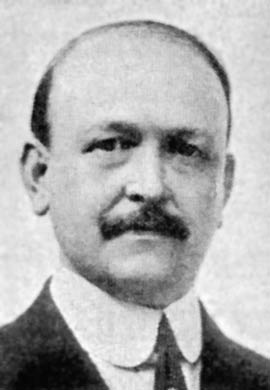 |
The Italian Heritage, published by the GHMCHS in 1985, states that in
1902 there were 1100 Italians living in Franklin County. Approximately
one hundred of them were men working as laborers at the various stone quarries
in Marble Cliff. Many of these workers were brought to this country by
Columbus steamship agent Ezio (Sam) Cherubini (above), whose offices were
at Spruce and Front Streets. Ezio arrived in Columbus in 1891 and was initially
sponsored by his prominent uncle, John Marzetti. He became the area’s first
Italian banker in 1910 and developed the business block at 509-525 N. Park
Street. Many of the immigrant laborers were single men who lived at the
“Italian Club” where monthly rent was one dollar, a very affordable rate
for workers whose daily pay ranged from seventy-five cents to two dollars.
Blacksmiths were at the top of the pay scale. |
|
| |
Pugh Residence |
 |
In June of 1903 John C. L. Pugh (inset) and his wife Mary Frisbie Pugh
purchased lots 290 and 291 in the J. R. Tilton’s Subdivision on the northwest
corner of First Avenue and Wyandotte Road. In 1913 they built this classic
four square home on lot 291. John Pugh was born in 1855 and was educated
in Columbus public schools. He graduated from Princeton in 1876 and was
admitted to the bar later the same year. His law offices were located on
High near State Street. He enjoyed a reputation as a skilled civil and
criminal litigator and in1898 was elected to the seventy-third Ohio General
Assembly, serving as Senator from the 10th district. Mary Pugh was the
daughter of the prominent Columbus grocery store magnate, Charles Harrison
Frisbie. John Pugh died in 1916 and his widow owned the home until 1921.It
is currently owned by Rodger and Jennie Wilson. Forty-five years later,
in 1966, another house was built on the corner on lot 290. |
|
| |
Twin Rivers Golf Course |
 |
Twin Rivers Golf Course, originally called Municipal Golf Course, was
an 18-hole course on the southeast side of Grandview that opened March
7, 1921. This was about the time the Aladdin Country Club in Marble Cliff
was closing. It was bounded by Twin Rivers Drive on the east, Dublin Road
to the south, and the rail road tracks to the north (to the right of the
photo). The clubhouse (top inset) was located at 860 Dublin Road, just
to the left of the lake in the photo. This Grandview landmark was eliminated
by freeway construction in 1956. Joe Thomas (bottom inset) was a local
golf legend and pro at Twin Rivers. He started as a caddy at Arlington
Country Club, and at 17 was the first to hold a caddy pin at the Scioto
Country Club when it was dedicated in 1916. When the Twin Rivers course
closed he was asked by then Columbus Mayor James A. Rhodes to find a venue
for another municipal course, and Joe founded the Raymond Memorial course
on Trabue Road. He remained as golf-pro there until his retirement in 1968. |
|
| |
Grandview Mens Club Wedding |
 |
This professional, posed photograph descended through the family of GHMC
Historical Society president Tracy Liberatore. Her great grandfather, Horace
Willoughby, is at the far left in the back row. The caption indicates that
the photograph is the “Men’s Club in Grandview” and dates from approximately
1923 (we have been unable to determine the affiliation of the men’s club.)
The subjects are all males and they are participating in a “mock wedding”
on the stage of the GHHS auditorium. A mock wedding is a parody, a bit
of folk theater in which people dress up in ridiculous fashion and go through
a ridiculous ceremony. The very tall bride, short groom, hefty ring bearer,
and burly flower girls all suggest that this was a comic production. The
elaborate, detailed, well-fitting costumes, together with the professional
photograph, suggest that this was an important production, perhaps a fundraiser.
Horace Willoughby was an influential Grandview citizen and owner of the
Ross-Willoughby Company. His family home at 1143 Westwood will be on the
historical society’s tour of homes May 13. |
|
| |
Lanman Mansion - Burgess & Niple |
 |
Sixty-years after it was installed, the opulent marble fireplace remained
a focal point in what was originally the living area of the Lanman mansion
at 2015 West Fifth Avenue. This 1968 photo shows clerical employees of
the Burgess and Niple civil engineering firm hard at work at their desks
with electric typewriters. The home was designed and luxuriously appointed
in 1908 by noted Columbus architect Frank Packard. Built for the Lanman
family prior to the introduction of federal income tax, during a period
of unabashed wealth for many early Columbus industrialists, the large Tudor
mansion became the corporate headquarters for Burgess and Niple in 1953.
The engineering firm moved to new headquarters in 1974. The Lanman home
retains many of its original appointments, including many such fireplaces,
and has remained a commercial venue, currently under the ownership of Marble
Cliff Manor, LLC. It will be featured as part of the GHMCHS home tour May
13. |
|
| |
5the Avenue Stagecoach |
 |
Prior to the turn of the last century, before the arrival of the streetcar,
access roads to the area that would eventually become the Village of Marble
Cliff and the City of Grandview Heights were limited. The main north-south
road was Dublin Pike (now Riverside Drive, or Dublin Road), which followed
the Scioto Indian trail. The main east-west road was Fifth Avenue. It had
a toll booth near Kenny Road, and wagons had to ford the Olentangy river
because there was no bridge. The stagecoach shown above was used in 1896
to transport passengers along Fifth Avenue. The picture is originally from
James T. Miller family collection. The 300-acre Miller farm was developed
into Upper Arlington after 1913. |
|
| |
Nick Botti |
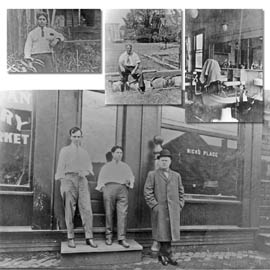 |
Nicholas Botti was born in Rutino, Italy in 1887 and arrived in Columbus,
Ohio when he was 16. He initially worked in his sponsor family’s grocery
store, spent time working in the Carmen Spaghetti factory on Goodale Avenue,
and finally settled on being a barber. His first barbershop was located
on Goodale and known as Nick’s Place. He relocated his family to Grandview
Heights and opened The Village Barbershop at 1668 West First Avenue in
1920. The photo on the right shows the interior of the shop which occupied
the east side of the building (upper right) The west side of his building
was leased to various tenants. Nick Botti became a master gardener and
maintained a garden to the rear of the barbershop (upper left and middle).
He was especially renowned for the quality of his strawberries and grapes.
Nick Botti died in 1974 at the age of 87. The Laura Gregory Hair Salon
currently occupies the shop on First. |
|
| |
RLS 3rd Grade Opera |
 |
The third grade class from Stevenson Elementary presented an original
opera entitled Choices, Changes, Rearranges on Tuesday May 22, 2007 in
the school auditorium. Their opera was written to celebrate Grandview Heights
and Marble Cliff history, and the setting was the Grandview Library. The
title reinforces the concept that choices people made yesterday affect
our lives today and the choices we make today can affect tomorrow. All
71 students created and participated in the multimedia presentation which
included original songs, a slide show, and various dance routines. Operas
and operettas are a long-standing tradition at R.L. Stevenson Elementary
School dating back to the school’s opening in 1927 when they were used
as fundraisers. Recently they have become part of the local history curriculum,
which uses the Grandview Heights Marble Cliff Historical website as a resource. |
|
| |
Grandview Turtle |
 |
Grandview Police Chief Robert “Rancho” Livingston is rescuing a turtle
at the corner of First and Virginia Avenues in this 1948 photograph, using
a shovel to place the turtle in the city’s radio cruiser. Befitting the
times he is wearing a suit and his trademark hat. The identity of the children
is unknown as are the circumstances surrounding the photograph. It is not
known whether this was a candid shot or staged as part of a municipal promotion.
Nonetheless, it is a testimony to the high level of community services
historically enjoyed by the citizens of Grandview Heights and Marble Cliff.
If anyone can identify any of the children in the photograph please contact
the GHMCHS. |
|
| |
Ruth Willoughby |
 |
Ruth Willoughby is shown standing in the front yard of her family home
at 1143 Westwood around 1917. The view is facing east towards Elmwood Avenue
and the home in the left background is 1156 Westwood. Grandview Heights
was incorporated in 1906, yet the area was still sparsely developed and
was rural by today’s standards. In the background are various small out
buildings and very few homes. Early residents kept chickens, goats, rabbits,
and larger live stock animals on their property and small barns and chicken
coops were common throughout the area. Tom Williams, who as a young boy
lived in the former Willoughby home from 1929 until 1943, raised pigeons
there with his brother. |
|
| |
Wilkinson Residence |
 |
These two photographs show the progression of construction of the home
built for Charlotte Wilkinson in 1913 at 1964 Cardington in Marble Cliff.
Charlotte was a widow who moved to Columbus from Ironton, Ohio with her
4 children so they could attend Ohio State University. Her husband, a West
Point graduate, died while serving during the Indian wars in the western
United States in the latter part of the nineteenth century. She also took
in boarders to help make ends meet. The home has remained in the family
for 94 years and is currently owned by her great-granddaughter Gail Johannes
and her husband Bill. The top right photo was taken soon after it was built
and shows the home of Roark family to the west of it, and the lower right
photo was taken in 1950. The porch and the area on the second floor with
the plants around it have since been enclosed. |
|
| |
I-670 Interchange at Grandview
Avenue |
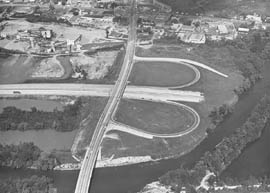 |
This 1970s photo shows Grandview Avenue from bottom to top over the incomplete
I-670 freeway (at the time referred to as Alt I-70). The upper left of
the photo shows a working stone quarry, which is now the location of the
Arbors of Watermark Apartments and business park. Planning for the freeway
was completed in 1971, and it was originally intended to be called I-70,
with I-70 and I-71 overlapping through downtown. In 1976 it was re-designated
as I-670 as part of a new master plan for a Columbus innerbelt connecting
I-70 and I-270 at the airport. Financial problems resulted in this dead-end
section of the road, and new environmental legislation, including a moratorium
on re-routing the Scioto River, delayed the continuation of the freeway
until it was finally opened in 2002. |
|
| |
Girls on Bikes |
 |
This 1896 photograph, from the Alleyne Higgs collection of the Grandview
Heights Marble Cliff Historical Society, shows two women posing with their
bicycles. The bicycle in front is a Lindsay Roadster, made in Indiana between
1895 and 1898, and the bicycle in back is likely a Columbia Bicycle, based
on the shape and details of the frame. The clothing styles were typical
of the time, as shown in a catalogue ad from 1895 at the right. Many of
the dresses had tabs attached at the bottom so that the skirt could be
tied around the calf to form "bloomers" to keep it out of the
spokes. |
|
| |
Emily Moelchert |
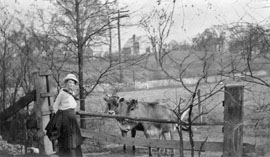 |
Emily Wilkinson Moelchert, who resided at 1964 Cardigan, posed with these
Brown Swiss dairy cows at the intersection of Cardigan and Dublin Road
in Marble Cliff around 1918. (At the time Cardigan extended completely
through to Dublin Road from the intersection of Roxbury.) The photograph
depicts a good example of the many limestone fences that lined Dublin Road.
The cows were owned by the Willits Sawyer family who lived on a three-acre
estate at 1499 Roxbury which comprised the entire western portion of Roxbury
between Cardigan and Third. Mr. Sawyer was the Director of Transportation
for New York City before moving to Marble Cliff, where his family supplied
milk and cream to the local residents. Emily lived to be 101 and attributed
part of her longevity to the Sawyer family’s fresh dairy products. |
|
| |
Mary Leaman |
 |
This 1934 photograph shows Mary Leaman, a 1933 graduate of Grandview
Heights High School, posing on the ladder of the diving board at the Grandview
Pool. The photo is from the collection of Ruth Shoemaker (class of 1934),
shown in the inset reading a book at the pool. Shoemaker lived at the corner
of First Avenue and Grandview Avenue, and Leaman lived on Wyandotte Road
just north of First. The caption of the photo reads in part "Step
right up, gentlemen, and enjoy a bit of romance with your drowning." |
|
| |
Dude Higgs and the Lindenbergs |
 |
This photo, circa 1922, was taken from a card labeled "Merry Christmas
Dude, from the Lindenbergs". Dude, shown sitting in front holding
the stuffed toy, was Dude (Frank) Higgs, who lived on Lincoln Road. The
Lindenbergs were from a prominent Marble Cliff family that lived in what
was known as the Country Club Subdivision, now Tarpy Woods. Dude Higgs
later was a pilot with the Chinese National Aviation Company, and was killed
in a crash in 1945 while flying to Shanghai. He was the model for the character
Dude Hennick from a popular comic strip "Terry and the Pirates" created
by his friend and OSU fraternity brother Milton Caniff. The last strip
that Dude was in was published on Christmas Day in 1945, and the original
is in the Cartoon Research Library collection at OSU. |
|






















